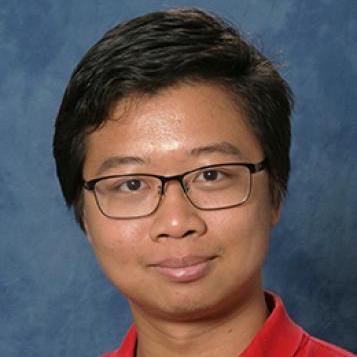POSTDOCTORAL RESEARCH FELLOW
Location
Climate & Space Research Building 2455 Hayward Street Ann Arbor, MI 48109
Education
- Ph.D., Planetary Sciences, The University of Arizona, 2021
- M.S., Planetary Sciences, The University of Arizona, 2017
- B.S. (with Honors), Double major in Physics and Planetary Science, California Institute of Technology, 2014
Research Interests
- Planetary atmospheres
- Planetary surfaces
- Remote sensing
- Space instrumentation
- Space mission design and operations
Publications
h-index: 16 (as of 7 July 2021)
Mars Atmospheric Chemistry and Escape
23. Lo D. Y., Yelle R. V., Lillis R. J., & Deighan J. I. (2021). Carbon photochemical escape rates from the modern Mars atmosphere. Icarus 360, 114371. doi: 10.1016/j.icarus.2021.114371
22. Lo D. Y., Yelle R. V., & Lillis R. J. (2020). Carbon photochemistry at Mars: Updates with recent data. Icarus 352, 114001. doi: 10.1016/j.icarus.2020.114001
21. Stone, S. W., Yelle, R. V., Benna, M., Lo, D. Y., et al. (2020). Hydrogen escape from Mars is driven by seasonal and dust storm transport of water. Science 370(6518), 824–831. doi: 10.1126/science.aba5229
20. Ajello J. M., et al. (2019). UV study of the Fourth Positive Band system of CO and O I 135.6 nm from electron impact on CO and CO2 . Journal of Geophysical Research: Space Physics, 124. doi:10.1029/2018ja026308
19. Jakosky B. M., et al. (2018). Loss of the Martian atmosphere to space: Present-day loss rates determined from MAVEN observations and integrated loss through time. Icarus, 315, 146–157. doi:10.1016/J.ICARUS.2018.05.030
Mars Atmospheric Tides
18. England S. L., Liu G., Withers P., Yiğit E., Lo D. Y., et al. (2016). Simultaneous observations of atmospheric tides from combined in situ and remote observations at Mars from the MAVEN spacecraft. Journal of Geophysical Research: Planets, 121, 594–607. doi:10.1002/2016JE004997
17. Lo D. Y., et al. (2015). Nonmigrating tides in the Martian atmosphere as observed by MAVEN IUVS. Geophysical Research Letters, 42 (21), 9057–9063. doi:10.1002/2015GL066268
MAVEN
16. Lo D. Y., et al. MAVEN/IUVS observations of C I 156.1 nm and 165.7 nm dayglow: Direct detection of carbon and implications on photochemical escape. Submitted to Icarus.
15. Schneider N. M., et al. (2018). Global aurora on Mars during the September 2017 space weather event. Geophysical Research Letters, 7391–7398. doi:10.1029/2018GL077772
14. Jain S. K., et al. (2018). Martian thermospheric response to an X8.2 solar flare on September 10, 2017 as seen by MAVEN/IUVS. Geophysical Research Letters, 45, 7312–7319. doi:10.1029/2018GL077731
13. Deighan J. I., et al. (2018). Discovery of a proton aurora at Mars. Nature Astronomy, 2, 802-807. doi:10.1038/s41550-018-0538-5
12. Stiepen A., et al. (2017). Nitric oxide nightglow and Martian mesospheric circulation from MAVEN/IUVS observations and LMD-MGCM predictions. Journal of Geophysical Research: Space Physics, 122 (5), 5782–5797. doi:10.1002/2016JA023523
11. Stevens M. H., et al. (2017). Martian mesospheric cloud observations by IUVS on MAVEN: Thermal tides coupled to the upper atmosphere. Geophysical Research Letters, 44 (10), 4709–4715. doi:10.1002/2017GL072717
10. Medvedev A. S., et al. (2016). Comparison of the Martian thermospheric density and temperature from IUVS/MAVEN data and general circulation modeling. Geophysical Research Letters, 43 (7), 3095–3104. doi:10.1002/2016GL068388
9. Jakosky B. M., et al. (2015). MAVEN observations of the response of Mars to an interplanetary coronal mass ejection. Science, 350 (6261), aad0210. doi:10.1126/science.aad0210
8. Schneider N. M., et al. (2015). Discovery of diffuse aurora on Mars. Science, 350 (6261), aad0313. doi:10.1126/science.aad0313
7. Bougher S. W., et al. (2015). Early MAVEN Deep Dip campaign reveals thermosphere and ionosphere variability. Science, 350 (6261), aad0459. doi:10.1126/science.aad0459
6. Thiemann E. M. B., et al. (2015). Neutral density response to solar flares at Mars. Geophysical Research Letters, 42 (21), 8986–8992. doi:10.1002/2015GL066334
5. Jain S. K., et al. (2015). The structure and variability of Mars upper atmosphere as seen in MAVEN/IUVS dayglow observations. Geophysical Research Letters, 42 (21), 9023–9030. doi:10.1002/2015GL065419
4. Evans J. S., et al. (2015). Retrieval of CO2 and N2 in the Martian thermosphere using dayglow observations by IUVS on MAVEN. Geophysical Research Letters, 42 (21), 9040–9049. doi:10.1002/2015GL065489
3. Stevens M. H., et al. (2015). New observations of molecular nitrogen in the Martian upper atmosphere by IUVS on MAVEN. Geophysical Research Letters, 42 (21), 9050–9056. doi:10.1002/2015GL065319
Waterfall Plunge Pools
2. Scheingross J. S., Lo D. Y., & Lamb M. P. (2017). Self-formed waterfall plunge pools
in homogeneous rock. Geophysical Research Letters, 44 (1), 200–208. doi:10.1002/2016GL071730
1. Scheingross J. S., Brun F., Lo D. Y., Omerdin K., & Lamb M. P. (2014). Experimental evidence for fluvial bedrock incision by suspended and bedload sediment. Geology, 42 (6), 523–526. doi:10.1130/G35432.1
Awards
- American Geophysical Union Outstanding Student Presentation Award (2020)
- The University of Arizona College of Science Galileo Circle Scholarship (2019)
- NASA Group Achievement Award – MAVEN Mission Team (2018)
- The University of Arizona Graduate and Professional Student Council Travel Grant (2018)
- Lunar and Planetary Institute Career Development Award (2018)
- NASA Group Achievement Award – MAVEN Science Team (2016)
- NASA RHG Exceptional Achievement for Science – MAVEN Science Team (2016)
- The University of Arizona Lunar and Planetary Laboratory Lieutenant Colonel Kenneth Rondo Carson and Virginia Bryan Carson Graduate Fellowship (2014)
- California Institute of Technology Fritz Burns Prize in Geology (2013)
